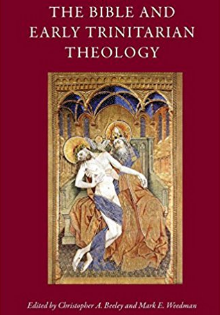Reviewed By: Michael Mates

This enormously erudite book, and its 12 authors, reemphasize the link between the exegetical writings of the Church Fathers and the text of the Bible, particularly the Gospel of John and the letters of Paul, by showing the development of Trinitarian theology from post-New Testament times to the 4th century. The authors write as heirs of the shift from the "older history-of-doctrine method, to the study of early biblical interpretation" (5). They generally accept the plain-sense integrity of the NT texts, except for two passages in which Rudolph Bultmann has a walk-on part describing the Father-Son relation in the Fourth Gospel as a "Gnostic Redeemer Myth" (94).
While closing the gap between the Bible and the fathers, the authors also argue that the distance between ancient texts and modern interpreters "is not a yawning abyss but is filled with the continuity of custom and tradition" (20). Several authors use that ancient-to-modern continuity to ignore the fathers and deal directly with the NT. However, all of them perform their exegeses with thoroughgoing skill, as they establish the flow from text to doctrines and creeds, "in multiple and sometimes circuitous channels" (23), to establish the doctrine that Father, Son and Holy Spirit are co-equally God. (Not all the authors subscribe to Nicene Trinitarian orthodoxy, and some show Arian sympathies, but they are in general agreement about what happened.)
Of interest is Tertullian's argument, from the Latin text of John 10.30, that Jesus and the Father are "one thing (unum)," but not "one person (unus)." Tertullian illustrates this by saying: "The ray is extended from the sun, it is still part of the whole; the sun will still be in the ray, because it is a ray of the sun" (115).
Implicitly opposed to the use of Latin in the argument, another author argues that Latin can lead the exegete astray, citing the Latin translation from the Greek of John 1.3: omnia per ipsum facta sunt, "All things were made through him." The Latin facta sunt is ambiguous, he argues, because facta can be the past participle of facio (made) or of fio (became) (128), thus muddying the issue of which Greek verb was used. Chosing facio supported a belief among some Latin readers that there was no distinction between the Logos and the things that were made - that is, they subscribed to the Arian belief that Christ was created at some point in time. The Greek verb egeneto ("became"), is completely different from the verb "to make" s(poiein) and thus avoids the ambiguity.
All this comes under the heading of "The Perfidy of Translators." It's interesting to note that the age-old antipathy in Classics departments, between Latinists and Hellenists, is alive and well, as well, in theology faculties!
(By the way, this reviewer doesn't grasp the distinction that the author draws between fio and facio, and the effect of the distinction, but takes it on faith that others did.)
Also of interest is Basil of Caesarea's meditation on the preexistence of Christ. He argues that "In the beginning" uses a "multivalence[d]... term," and that there are events prior to many beginnings, as when "the letters are the beginning of a word when they are put together" (137). Basil also discusses the importance of the Greek word pros ("with") in John 1:1: "If John 1.1had said that the Word was "in" God, then it would lend support to the Marcellan position that Father and Son are really one individual existent" (145). The author could also have pointed out that pros speaks of an active "withness," as opposed to the other Greek word for "with" (syn), which has a quieter feel to it.
There is, of course, much more in this well-stuffed jewel bag of a book, which, in my book, gets five stars for interest, depth and comprehensiveness.
Click Here for More and to Purchase
